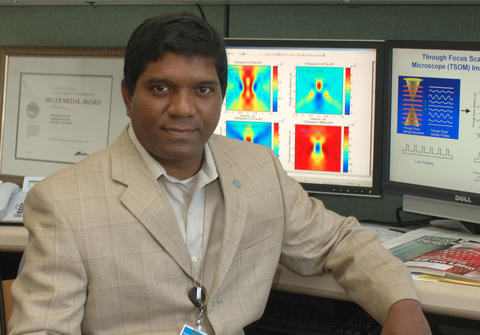
Ravikiran Attota, a lead researcher in NIST's Precision Engineering Division, won an R&D 100 Award for his development of the Through-Focus Scanning Optical Microscopy (TSOM), which has applications that cut across a range of industries, from biotechnology to semiconductors and photonics.
A radical, new method developed at NIST that transforms the humble, ubiquitous and inexpensive optical microscope into a powerful three-dimensional nanoscale and microscale measurement device has won one of this year's prestigious "R&D 100 Awards." The annual R&D 100 Awards program recognizes "the 100 most technologically significant products introduced into the market" during the previous year, as selected by an independent judging panel and the editors of R&D Magazine.
Developed by Ravikiran Attota, a lead researcher in NIST's Precision Engineering Division, Through-Focus Scanning Optical Microscopy (TSOM) has applications that cut across a range of industries from biotechnology to semiconductors and photonics. TSOM can be used for defect analysis, inspection and process control, critical dimension metrology, photomask metrology, overlay registration metrology, nanoparticle metrology, film thickness metrology, 3-D interconnect metrology (large-range depth analysis such as through-silicon vias—TSVs), and line-edge roughness measurements.
The method uses a conventional bright field optical microscope, but rather than taking a "best focus" image, it collects 2-D images at different focal positions. A computer then extracts brightness profiles from these multiple out-of-focus images and uses the differences between them to construct the TSOM image.
This new imaging technology requires a research-quality optical microscope, a digital camera and a motorized microscope stage that can move up and down to preset distances.
"The method is relatively simple and inexpensive, has high throughput, and provides nanoscale sensitivity for 3-D measurements," says Attota. "It has the potential to save companies millions of dollars."
Read more about the award winners at R&D Magazine.
For more information about Attota's technique, see http://www.nist.gov/pml/div683/grp03/upload/tsom-ravikiran-attota.pdf.

